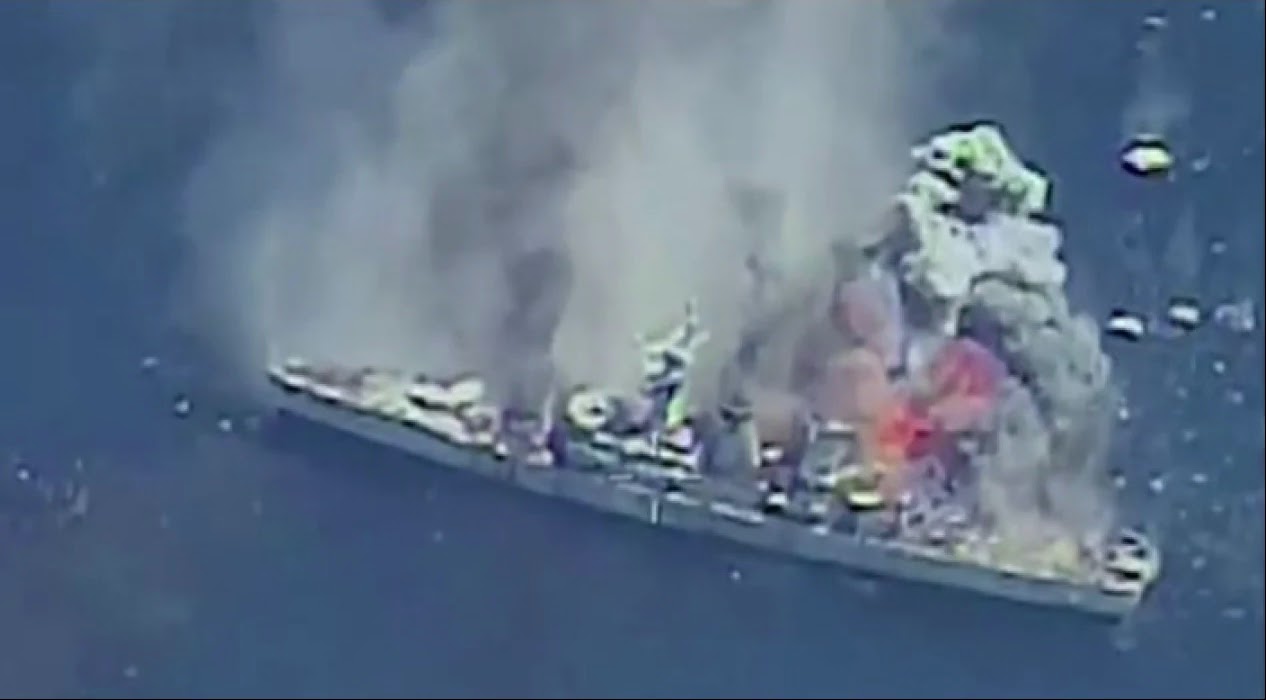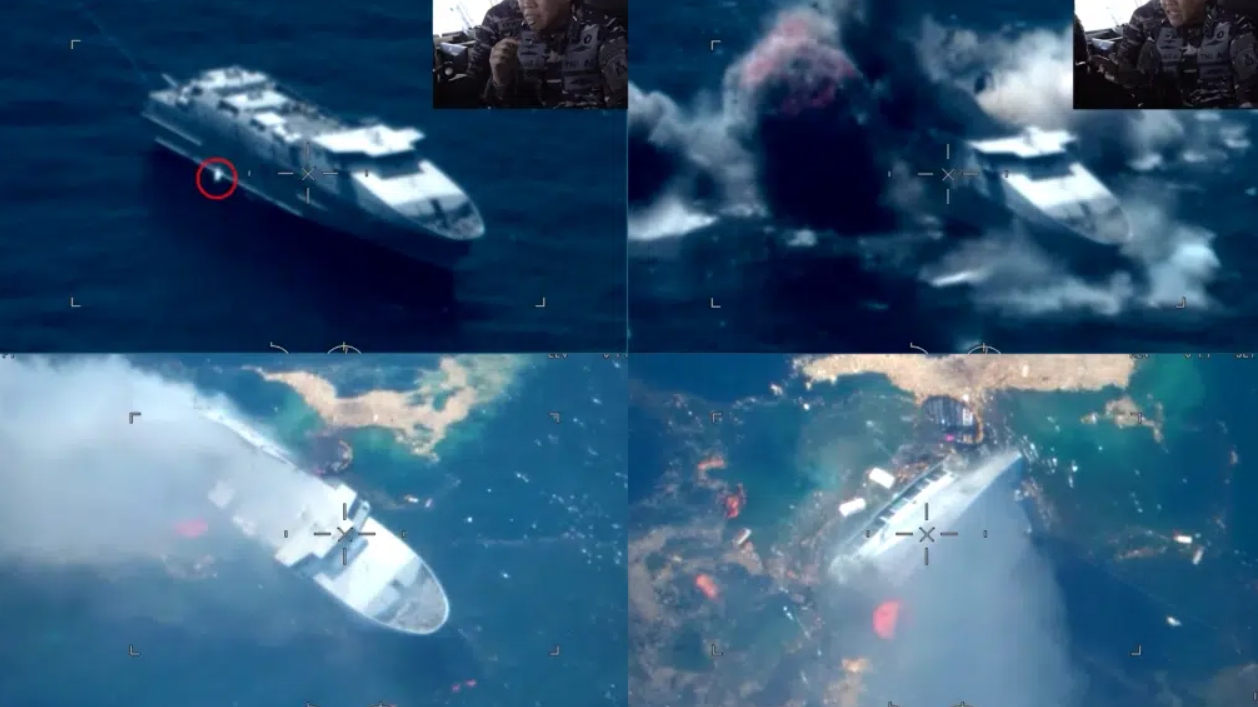The Indonesian Navy sunk an old decommissioned warship by firing four anti-ship missiles from its warships while also employing an F-16 fighter from its air force as a part of a training exercise earlier this week.
Su-57 Stealth Fighter: Russia Claims Developing ‘Super Missile’ That Can Even Shoot Down A Trailing Aircraft
It used French and Chinese-made anti-ship missiles (AShMs) to “improve military preparedness and refine their war doctrine.”
The exercise in the Java Sea comes amidst increased tensions between the United States (US) and China in the western Pacific. Washington is shoring up a regional alliance against Beijing as a part of its ongoing strategic rivalry.
Indonesia assumes significance in the scheme of things owing to its status as one of the parties contesting maritime boundary claims in the South China Sea (SCS) with China and its political importance as one of the most-important Association of South East Nations (ASEAN) countries.
Courted by both Washington and Beijing, Jakarta has often had to do a tricky balancing act since it otherwise has chosen neutrality and repeatedly stated it prefers not to take sides in the great power rivalry.
Nevertheless, It has consistently modernized its military through imports, joint defense production, and a substantial amount of indigenous development, indicating it envisages a bigger military and strategic role in regional politics.
Four Ships, Four Missiles, One Jet Vs. One Target
According to a statement from the Tentara Nasional Indonesia Angkatan Laut (or TNI), the “Joint Exercise (Lagtab)” involved the KRI Slamet Riyadi being selected as the target vessel and the French-origin Exocet SSM Block 3 and Chinese C-802 and C-705 as the AShMs for the firing. The missiles fired by the four warships — frigates KRI Yos Sudarso, KRI RE Martadinata, corvette KRI John Lie and rapid missile boat KRI Tombak — “right on target causing damage and fire,” according to a report on Kompas TV.
Videos showed four missiles hitting different parts along the length of the ship on the starboard (right) side, with significant explosions, before the entire ship was engulfed in flames. While the TNI report did not specify the role of the F-16, Kompas TV claimed the jet “hit (the target ship) with two bombs dropped by Indonesian Air Force F-16 fighters.” Presumably, the vessel then capsized and sank.

Follow EurAsian Times on Google News
The KRI Tombak fired the C705, KRI Martadina, and KRI John Lie fired the MM40 Exocet, and the KRI Sudarso fired the C802. TNI Commander Admiral Yudo Margono said in his statement, “It is our shared pride to increase the professionalism of TNI soldiers, both land, sea, and air, and tomorrow will be continued with joint TNI operations.” As for the target ship, the KRI Riyadi was commissioned in the Indonesian Navy in 1987 and has not been operated since August 2019.
Regarding the missiles’ capabilities, the SSM Exocet MM40 Block 3 has a speed of Mach 0.93, with a cruising range of 6.5-97 Nautical Miles (NM) and a cruising height of up to 9 meters. The C-802 missile has a speed of Mach 0.9, with a cruising range of 5.4-64.7 NM and a cruising height of up to 20 meters. Meanwhile, the C-705 missile has a speed of Mach 0.8 Mach, can reach 6-70 NM, and fly up to 20 meters at cruising speed.
Chief of Staff of the TNI Muhammad Ali added that besides readiness for “war military operations,” the drills are also aimed at “improving interoperability” between TNI forces and other militaries. This hinted that Indonesia is willing to participate in joint operations with both China and the US as the country pursues its neutral and non-aligned foreign policy amid a new cold war, as explained subsequently.
Balancing Act Between US & China
Indonesia’s primary defense concern is the maritime border dispute with China, where there is only an undercurrent of military tension as Jakarta and Beijing have managed to keep the issue limited to a political dimension. Nevertheless, the archipelago has had its share of maritime incidents with Chinese vessels over the past years. It is currently working to establish a code of conduct (COC) with China for the South China Sea.
The South China Sea, in particular, represents an area where Beijing has assertively expressed its territorial claims to various disputed shoals, overlapping Exclusive Economic Zones (EEZ) and maritime boundaries. China’s claims are vast and extensive enough to claim the entire water body as its own.
Sinkex TNI AL (Indonesia Navy)
1x C705 from KRI Sampari 629
1x MM40 Exocet from KRI Raden Eddy Martadinata 331
1x C802 from KRI Yos Sudarso 353
1x MM40 Exocet from KRI John Lie 358Target EX-KRI Slamet Riyadi 352 pic.twitter.com/ByHnFUmTmJ
— WiwekaZaqi (@OKAZAQI_) July 31, 2023
One way of asserting its territorial right has been by artificially expanding some existing islands, building new ones, and establishing a permanent military presence by having radar, naval, and air base installations. Philippines, Vietnam, and Brunei are three other countries with whom Beijing has conflicting claims, with Manila also having some artificial structures. Indonesia’s exclusive economic zone (EEZ), which surrounds the Natuna Islands, partially overlaps with an area in the South China Sea claimed by Beijing.

However, Indonesia holds a significant place in Southeast Asian politics and the ASEAN, given both its economic and political significance. It is thus courted by both the US and China, with the US engaging it primarily with defense technology through arms sales and China with high levels of investment and trade.
It has poured US$5 billion into Indonesia in the first nine months of 2022, compared to US$2 billion by the United States during the same period.
Thus the US views Indonesia as crucial if the former clashes with China in the western Pacific. However, Indonesian officials have stressed directly and indirectly that the country would remain neutral in a possible conflict between China and the US. But the TNI underlined its dual engagement and non-aligned stance through a multilateral naval exercise involving both the US and Chinese navies in early June.
In some instances, Jakarta has openly criticized military blocs led by the US aimed at China, saying they cause regional tension and destabilization. The Australia-United Kingdom-United States (AUKUS) nuclear submarine deal was one such pact that saw both Indonesia and Malaysia expressing concern that it would trigger a regional arms race.
- The author can be reached at satamp@gmail.com
- Follow EurAsian Times on Google News




